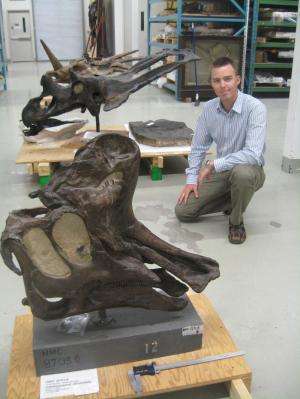Dinosaurs, diets and ecological niches: Study shows recipe for success

A new study by a Canadian Museum of Nature scientist helps answer a long-standing question in palaeontology—how numerous species of large, plant-eating dinosaurs could co-exist successfully over geological time.
Dr. Jordan Mallon, a post-doctoral fellow at the museum, tackled the question by measuring and analyzing characteristics of nearly 100 dinosaur skulls recovered from the Dinosaur Park Formation in Alberta, Canada. The specimens now reside in major fossil collections across the world, including that of the Canadian Museum of Nature. The work was undertaken as part of his doctoral thesis at the University of Calgary under the supervision of Dr. Jason Anderson.
Mallon's results, published in the July 10, 2013 issue of the open-access journal PLOS ONE, indicate that these megaherbivores (all weighing greater than 1,000 kg) had differing skull characteristics that would have allowed them to specialize in eating different types of vegetation. The results support a concept known as niche partitioning, which dates to the 19th-century studies of Charles Darwin and came into its own in the 1950s with the development of the science of ecology.
The Dinosaur Park Formation is between 76.5 and 75 million years old and is known for its rich concentration of dinosaur remains. The rock unit has yielded nearly 20 species of megaherbivores from the Late Cretaceous period. Of these, six species would have coexisted at any one time, including two types of ankylosaurs (tank-like armoured dinosaurs), two types of hadrosaurs (duck-billed dinosaurs), and two types of ceratopsids (horn-faced dinosaurs).
Modern megaherbivores include elephants, giraffes, hippos and rhinos. "Today's megaherbivore communities are not nearly as diverse as those from the Late Cretaceous of Alberta, and most other fossil communities also pale by comparison. So the question is: how does an environment support so many of these large herbivores at once?" asks Mallon.

Mallon tested two competing hypotheses. The first is that availability of food was not a limiting factor in species survival. Plants may have been either super-abundant, so the megaherbivores did not have to compete for food, or the dinosaurs' metabolisms were relatively low, so the environment could support more species relative to a fauna comprised entirely of high-metabolic animals.
The second hypothesis is that the available food resources were limiting and that niche partitioning came into play; in other words, there weren't that many plants to go around so that the species had to share available food sources by specializing on different types of vegetation.
"If niche partitioning was in effect, then you would expect to see various dietary adaptations among the coexisting dinosaur species," explains Mallon. "So you would look for differences in the shapes of the skull, in the teeth, and in the beaks that might reflect adaptations for feeding on diverse plants or plant parts." These differences, for example, would reflect whether a dinosaur was adapted to feeding on soft or hard plant tissues.
Until Mallon's study, neither of these hypotheses had been rigorously tested with such a large sample size. For each of the nearly 100 dinosaur skulls he studied, Mallon measured 12 characteristics that are known to relate to diet in modern animals. These include depth of the jaw, angle of the beak, size of muscle insertions, and length of the tooth row. "We can apply those same functional and mechanical principles to dinosaurs to see what they might tell us about niche partitioning."
Not unexpectedly, differences were found between the three major groups (ankylosaurs, hadrosaurs and ceratopsids). But more striking were the subtle yet significant differences within each of the three groups that were probably related to feeding. "We found those differences that were previously suspected but never demonstrated," explains Mallon.
As an example, the palaeontologist suggests that ankylosaurs probably specialized on eating ferns, because they stood low to the ground, and their wide beaks would have allowed them to feed efficiently on abundant, relatively low-nutrient plants. However, within this group, the family known as nodosaurids (clubless ankylosaurs) had more efficient jaw mechanics that might have enabled them to include tougher plants in their diets. In contrast, ceratopsids had skulls that suggest they were adapted to feeding on mid-sized shrubs, while the taller hadrosaurs were less picky and would have fed on anything within reach.
Although different species came and went, the same ecological roles were filled over the 1.5 million year span of the Dinosaur Park Formation. "This tells us that niche partitioning was a viable strategy for the coexistence of these animals," adds Mallon. "The study provides further evidence to explain why dinosaurs were one of the most successful groups of animals to live on this planet."
Journal information: PLoS ONE
Provided by Canadian Museum of Nature


















